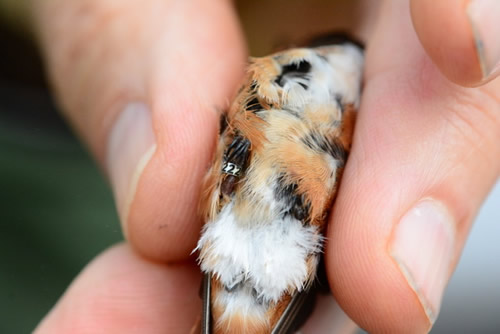Hummingbird Banding
Regulation of the Banding Process
 Female Rufous Hummingbird showing temporary color marking being applied by licensed bird bander (Photo courtesy of JSS3) |
Bird banding is a valuable process in the study of the movement, survival and behavior of birds.
The banding of hummingbirds is a carefully regulated process that must be performed only by trained and licensed banders.
The federal Bird Banding Laboratory (BBL) is administered by the United States Geological Survey, with a similar program operated by the Canadian Wildlife Service. The BBL is headquartered in Laurel, Maryland. For more information, visit the website of the USGS Bird Banding Laboratory (BBL)
The BBL authorizes trained personnel to capture and band wild birds, including hummingbirds, for research and educational purposes. Hummingbird bands are issued only to banders who have received training on the specialized banding techniques and are authorized to band specified species.
Purposes of Hummingbird Banding
Identification makes possible studies of species dispersal and migration, behavior, life-span, survival rate, reproductive success and population growth.
When banded birds are captured, released alive and reported from somewhere else, researchers can monitor the movements of an individual bird.
How the Banding is Performed
Hummingbird traps are carefully monitored, and when a bird visits the feeder a release mechanism is triggered to drop a curtain or lower a door. This method is not perfect or foolproof, as some hummingbirds escape while others will avoid the traps altogether.
 Male Rufous Hummingbird with temporary marking on its head (Photo courtesy of JSS3) |
Once carefully extracted from the trap, each bird is transferred to a soft mesh holding cage and checked to see if it has previously been banded.
Each "new" (unbanded) bird receives a band marked with a unique number which will be recorded in the BBL database.
In addition to the band, hummingbirds are often identified with a temporary color-mark so that the bird can be identified again without retrapping. The color only lasts for a while, and disappears as plumage is replaced.
Banding an Overwintering Rufous in Tennessee
A male Rufous Hummingbird has spent his fifth winter in Clinton, Tennesse, as of 2022. He has appeared at a feeder almost daily since August 10, 2019 (a week later than he showed up in 2018).
He was banded in January 2018 and recaptured the following August. Numerous pictures of him have been taken, some of which show different parts of the band number K58222.
According to the bander, there are at least two female Rufous Hummingbirds banded this year in the Knoxville, TN area, along with a Blackchin female about 30 miles south.
| Placing the band on the Rufous Hummingbird (Photos by Mark Armstrong) | |
 |
 |
| Band K58222 in place on the Rufous Hummingbird (photo by E. Pat Howard) | |
 |
|
The BBL Database
When a bird is banded, the bander collects data about the bird's age, sex, condition, and plumage characteristics. Measurements include the wing chord (length of the flattened wing from wrist to tip of the longest primary feather), tail length, mass, and bill length. After the bird is banded and released, the bander files data with the BBL.
Whenever a banded bird is recaptured by another bander, the information is also sent to the BBL. The banding lab notifies the original bander of the place and date their bird was recaptured. The bander who recaptured the bird is also notified where and when the bird was originally banded.
For more information, visit the website of the USGS Bird Banding Laboratory (BBL)
